The Vitus E-Sommet VRX electric mountain bike is the direct-to-consumer brand’s top-spec and longest-travel model designed specifically for the rigours of enduro riding.
In true Vitus fashion, the VRX is draped in high-end components for a reasonable price tag.
For £5,499.99 / $6,099.99 / €6,999.99, you get a RockShox Zeb Ultimate fork, Shimano’s M8100 XT drivetrain and brakes, and a Shimano EP8 electric bike motor.
Keeping up with the latest trends, the E-Sommet runs mullet wheels (29in front, 27.5in rear) and has modern – albeit not trend-setting geometry – boasting a 64-degree head tube angle and a 478mm reach on a size-large bike.
On paper, there’s a lot to like about the relatively affordable Vitus, but does it manage to blend price, weight and performance out on the trails?
Vitus E-Sommet VRX frame, suspension and motor

Built from 6061-T6 aluminium, the E-Sommet’s frame boasts integrated chainstay, down tube and motor protection. This reduces noise from chain slap and the chances of damage from rock strikes or other impacts.
The bike’s cables are routed internally via the Acros headset’s bearing cap. This is an increasingly common design many manufacturers are using.
The headset also has a steering block. This stops the bars turning too far and potentially damaging the frame.
The tapered head tube goes from a 1 1/8in upper to 1.8in lower. This is a chunkier standard used most often on electric bikes to help increase stiffness.
It has 12x148mm Boost rear-axle spacing and runs SRAM’s Universal Derailleur Hanger (UDH).
Suspension kinematics
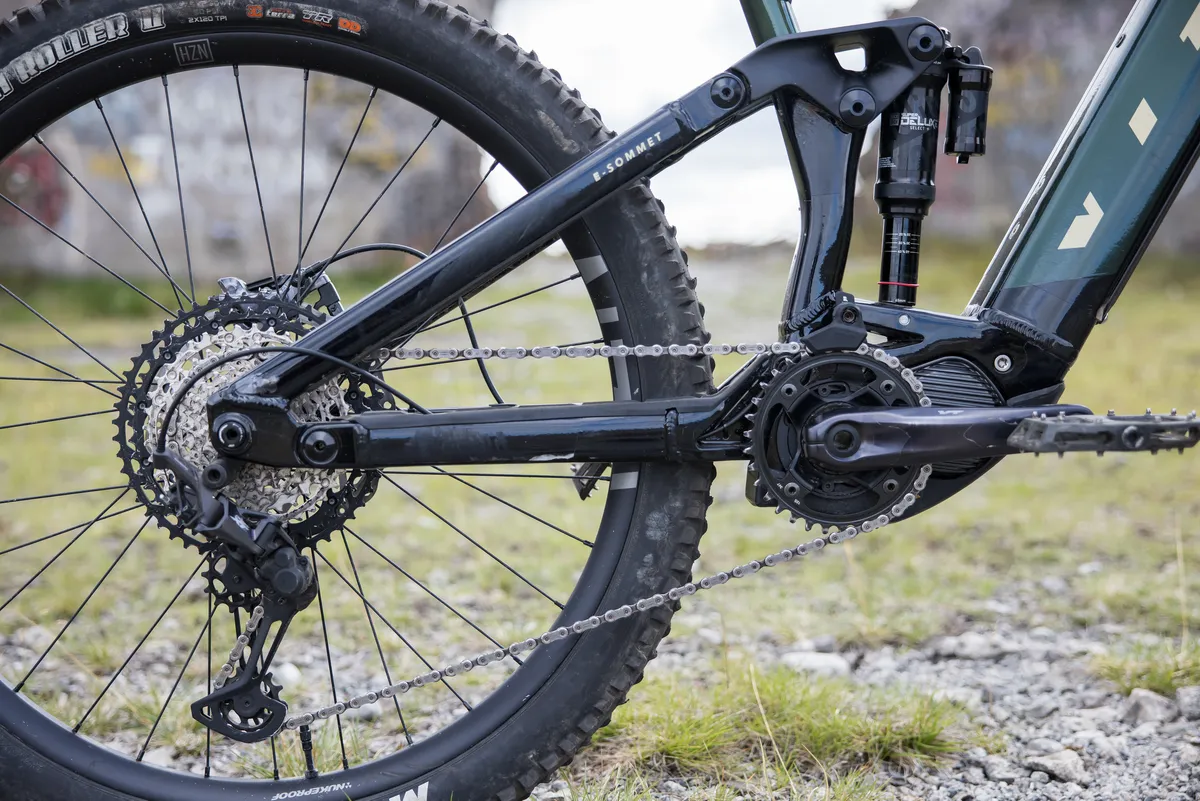
According to Linkage Design, the E-Sommet’s 167mm of rear-wheel travel has a relatively progressive leverage rate where suspension forces increase in a linear fashion as it compresses.
Overall, the leverage rate has 24 per cent progression from full travel to bottom-out. This makes it well suited to either air-sprung or coil-sprung shocks, where there should be plenty of bottom-out resistance for the linear nature of coils.
Anti-squat at sag in the largest cassette sprocket is 85 per cent. This means pedalling forces are more likely to cause the bike’s suspension to compress and extend (called suspension bob) compared to bikes with a higher number.
Anti-rise sits between 45 per cent and 50 per cent throughout the bike’s travel, meaning braking forces are more likely to cause the suspension to extend rather than compress. This, in theory, should make the suspension more active under braking.
Vitus E-Sommet VRX battery and motor

Shimano’s EP8 motor is paired with the brand’s BT-E8036 630Wh battery. This is stored in the down tube and is hidden behind a cover that’s fastened in place with three hex bolts.
The motor has 85Nm of peak torque and 250W of peak power. It’s compatible with Shimano’s E-Tube Project smartphone app, which enables you to customise its performance.
A top-spec colour SC-EM800 display is fitted, along with the SW-EM800 switch.
Vitus E-Sommet VRX geometry

Although the E-Sommet’s geometry figures aren’t extraordinarily long, low or slack, they are modern and well suited to the bike’s intended enduro racing remit.
My size-large test bike features a 64-degree head tube angle and a high 649mm stack.
| Size | Small | Medium | Large | Extra-large |
|---|---|---|---|---|
| Reach (mm) | 430 | 450 | 478 | 505 |
| Stack (mm) | 645 | 645 | 649 | 658 |
| Head angle (degrees) | 64 | 64 | 64 | 64 |
| Seat tube angle (degrees) | 77 | 77 | 77.5 | 78 |
| Chainstay (mm) | 442 | 442 | 442 | 442 |
| Top tube (mm) | 581 | 601 | 624 | 648 |
| Wheelbase (mm) | 1,217 | 1,235 | 1,267 | 1,298 |
| Bottom bracket drop (mm) | 35 | 35 | 35 | 35 |
This is combined with a roomy 478mm reach figure and 634mm effective top tube length. There’s a 77.5-degree effective seat tube angle, which gets progressively steeper as the frame’s size increases.
Chainstays are 442mm across the sizes, while the large’s wheelbase is 1,267mm. It has 35mm of bottom-bracket drop, which equates to a 330mm bottom-bracket height.
Vitus E-Sommet VRX specifications

The E-Sommet VRX’s specification is impressive for the cash.
RockShox dampers feature front and back with a 170mm-travel Charger 2.1 Zeb Ultimate fork and a custom-tuned Super Deluxe Select+ RT shock.
A full-house Shimano 12-speed XT M8100 drivetrain features. This is matched with Shimano’s four-piston XT M8120 brakes, which are fitted with finned, sintered pads and 203mm rotors.

High-quality Nukeproof (Vitus’ sibling brand) Horizon components are widely specced. These include Horizon V2 wheels, along with Horizon V2 bars, stem and saddle.

Brand-X (also a Vitus sibling brand) supplies the Ascend dropper post. The size-large frame gets the 170mm-drop version.
Without pedals, the large test bike weighed 25.2kg.
Vitus E-Sommet VRX ride impressions

I tested the Vitus E-Sommet in Scotland’s Tweed Valley on my home trails over the course of several months.
Testing included riding the trails used for the UK’s round of the Enduro World Series and downhill tracks used at national-level events, through to mellow trail-centre runs and cross-country all-day epics exploring the Scottish Lowlands.
Taking in such a variety of terrain helped me build a clear picture of where the E-Sommet performs and where it doesn’t.
Vitus E-Sommet VRX setup

Setting up the E-Sommet’s RockShox dampers was relatively straightforward.
I set the fork’s air spring to 70psi and left the two stock volume-reducer spacers in the positive chamber. This gave me 20 per cent sag, providing good off-the-top sensitivity but plenty of ramp up towards bottom-out.
I left the high-speed compression adjuster fully open, but increased low-speed compression by two clicks from fully open to provide more support. I set the rebound to taste, which was nearly fully open.

Initially, I inflated the rear shock’s air spring to 170psi and left the two factory-installed volume-reducer spacers in the air chamber. This gave me 26 per cent sag.
During testing, however, I felt the light shock tune would benefit from increased spring pressure because I was using full travel too often and regularly diving deep into the mid-stroke in turns or through compressions.
I increased pressure incrementally, settling on 198psi. I also increased the number of volume-reducer spacers to three.

Although this reduced sag because the shock’s damper tune is so light, small-bump sensitivity wasn’t negatively affected. Set like this, the bike stayed further up in its travel in high-load settings and bottomed out less.
It’s refreshing to see a lighter damper tune compared to the general trend of over-damped factory settings.
Although relying mostly on spring pressure for ride height is a compromise, not having the damper limit the suspension’s ability to eat bumps meant the rear end felt great despite the lower than usual sag. Plus, this setup was well balanced with the Zeb fork.
Vitus E-Sommet VRX climbing performance
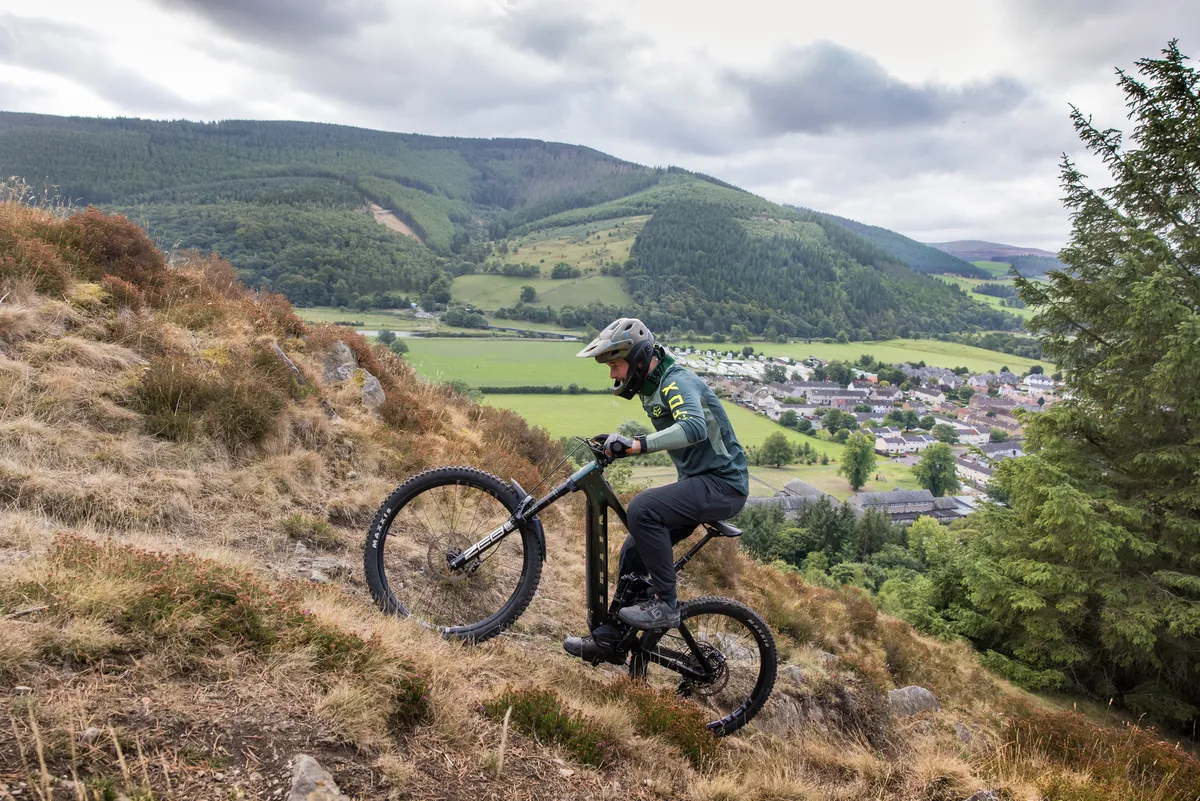
Pointing uphill, there’s a marvellous comfort to the E-Sommet’s rear suspension. It flutters in and out of its travel, absorbing the smallest, high-frequency bumps with ease.
Square-edged bumps found on worn-out trail centre surfaces or rock-strewn ascents do little to upset the bike’s balance. The rear wheel moves up and out of the way of bumps easily and proficiently, isolating the bike’s chassis from destabilising inputs.

Not only does this make the E-Sommet hugely comfortable, but it also boosts grip because the rear tyre is stuck to the trail as it conforms to its contours.
Spicy rocky, root-strewn or technical ascents are turned into fun, rather than daunting affairs. Thanks to the masses of grip on offer, they are much easier to attack without the risk of wheel spin.
The grippy Maxxis High Roller II rear tyre helps maximise traction. The steep ramps of the tyre’s tread dig into soft ground well, while the MaxxTerra compound is tacky enough to stick to slimy rocks and roots.

Rear-end traction and small-bump smoothness are mirrored by the Zeb Ultimate, which proves a worthy partner to the E-Sommet’s plushness.
Although the Vitus’ anti-squat figure suggests the bike should bob under power, this only happens at lower pedalling cadences.
Spin the cranks in an easier gear and the rear end remains impressively neutral, only dipping in and out of its travel when my pedalling became choppy.
If your pedalling style isn’t hugely smooth, the EP8 motor is on hand to help claw back any losses to unwanted suspension movement.
Its riding position enhances the suspension-based comfort, where the relatively short top tube places me more upright – a stance preferred by winch and plummet enduro-style riders.
Rider weight is biassed to the saddle rather than the bars, helping reduce shoulder and hand fatigue on long slogs to the trailhead.

Despite the fact Vitus has increased the seat tube angle on this generation of the E-Sommet, swapping between bikes with steeper figures such as Pole’s Voima and Marin’s Alpine Trail E2 revealed the E-Sommet would benefit from an even steeper figure.
Being critical, I would have preferred my hips to sit further over the bottom bracket rather than behind it to improve pedalling efficiency and comfort.
It would also enhance the E-Sommet’s already impressive climbing abilities, because a more centralised position means applying weight to either the front or rear wheel requires less exaggerated movements. This reduction in dramatic weight shifts helps minimise wheelspin or front-wheel lift because either end of the bike is less likely to go light.
Generally, though, the E-Sommet is a fun, engaging and highly capable bike on the climbs. This certainly extends its scope beyond enduro-only into the realms of super-sorted trail bikes.
Vitus E-Sommet VRX battery life

Weather conditions, riding style, rider weight and trail type will all play their role in how much battery range the E-Sommet has.
For my 76kg kitted-up weight, on a single charge I managed to frequently hit between 1,400m and 1,600m of ascent in mixed-mode usage, with that rising to between 1,800m and 2,000m of ascent using exclusively Eco mode.
Smash about in Turbo and you can expect that range to come tumbling down to anywhere between 1,100m and 1,300m of ascent.
Vitus E-Sommet VRX descending performance

Descending on the E-Sommet is like sliding into your favourite and most comfortable shoes – everything feels as though it’s in the right place, and does exactly what you want it to, when you need it to.
Its rear end’s super-smooth and supple action irons out the roughest of trails with impeccable precision. Grip is high and destabilising chassis pitch (caused by larger bumps) is minimised vastly by the terrain-gobbling suspension.
This helps maintain control and makes riding at higher speeds easier because dramatic weight shifts fore and aft to counter the rising and sinking of the bars and back end aren’t needed.

Its proficient suspension is augmented by the frame’s geometry, where the front-to-back balance feels great.
That balance gives it an intuitive, confidence-inspiring feel. Cornering stability is as good as the way it resists pitch over bumps.
Clearly, the relatively high stack (649mm) and low bottom bracket (330mm) are a winning recipe. Weighting the front end didn’t make me feel like I was peering over the edge of a cliff, and neither did it significantly reduce traction at the back end.

Steep, gnarly sections of trail didn’t faze the E-Sommet. Once again, that high front end and low bottom-bracket height come into play.
I could push against the high bars as the bike’s nose pitched forwards, adding control on the steeps, while the low bottom bracket meant my feet didn’t feel as if they were lifting higher than my hands once the front end dipped down.
Putting pressure through the front wheel to drive grip felt natural too, and the Zeb’s mid-stroke support helped maintain the E-Sommet’s geometry in high-load situations. This wasn’t at the sacrifice of small-bump absorption, where the Charger 2.1 damper excels.

Once I’d added an additional volume-reducer spacer and upped air pressure, there was plenty of mid-stroke support and bottom-out resistance.
In my opinion, the mullet bike claim of stability at the front and agility at the back oversimplifies the concept, as mountain bike handling exists on a continuum rather than being binary.
Indeed, rather than possessing these two opposing characteristics in isolation, the E-Sommet shows how well the blended traits of a mullet setup work.
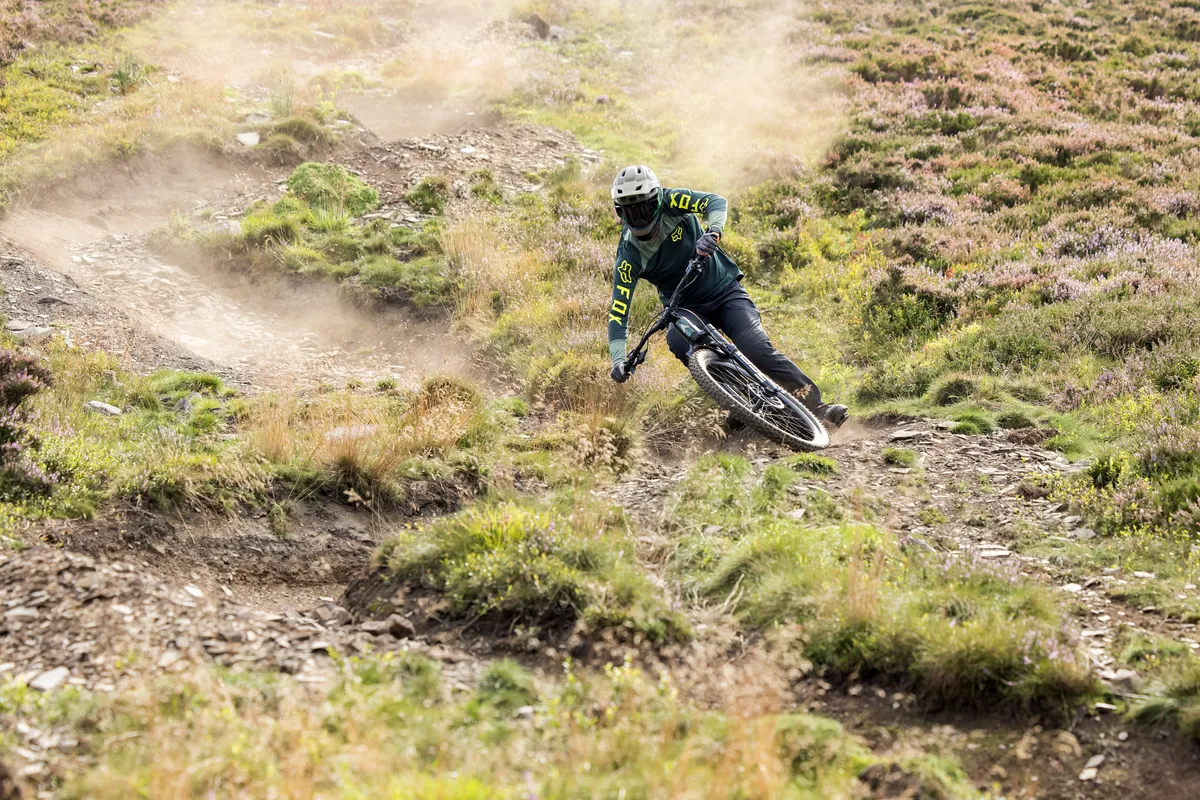
Although I'm reluctant to fall back on cliches about mullet-bike performance, there's no doubt the E-Sommet shows the setup can really work – there's a mix of characteristics, especially in the corners.
Louder, faster and quicker movements made the rear end break traction relatively easily, but rather than all hell breaking loose, the snaking rear end was easy to charm back into shape.

The effortlessness of bringing the bike back into check with small corrections made smashing corners addictive and exhilarating – although it isn’t the fastest way of riding, it is a lot of fun.
It responds just as well to a lighter touch. Feeding weight and grip in gradually means carving smoother arcs, and with an even weight distribution the back end doesn’t break traction and allows speeds to stay higher.
The E-Sommet felt good riding with both styles, and its versatility is a significant draw.
How does the Vitus E-Sommet VRX compare to the Nukeproof Megawatt?
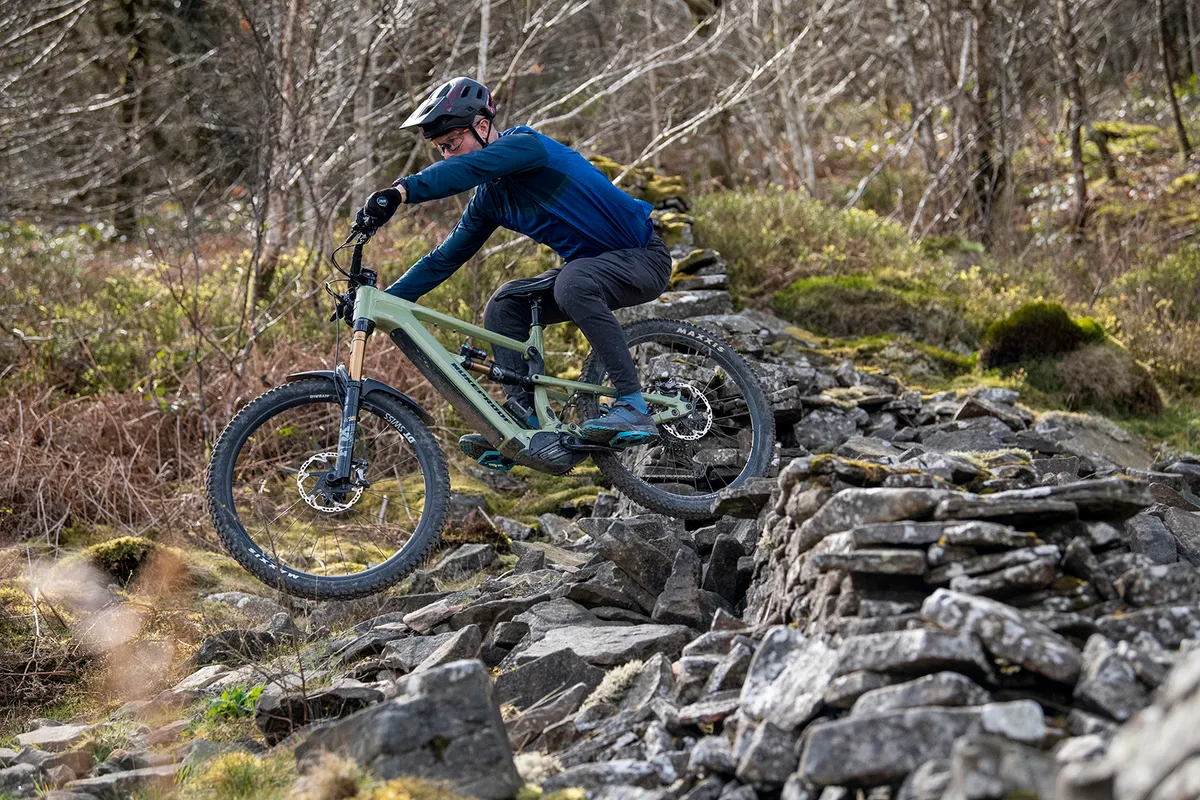
The most obvious competitor to the E-Sommet VRX is the Nukeproof Megawatt 297 Factory. The Megawatt won our 2022 Bike of the Year ebike category.
The eagle-eyed will spot the bikes share a number of their tubes, both have Horst-link rear-suspension designs, and – more obviously – both run mullet wheels.
Geometry is similar, with each bike's key figures almost identical, where they share a low bottom bracket and a high stack. Of course, this is no coincidence given the almost industry-wide convergence on sweet-spot geometry.
It’ll also come as no surprise that they have a similar feel out on the trail. While the Nukeproof Megawatt 297 Factory is damped by Fox suspension, and the Vitus with RockShox, both are fun and intuitive to ride from the get-go, with impressively predictable, stable handling.
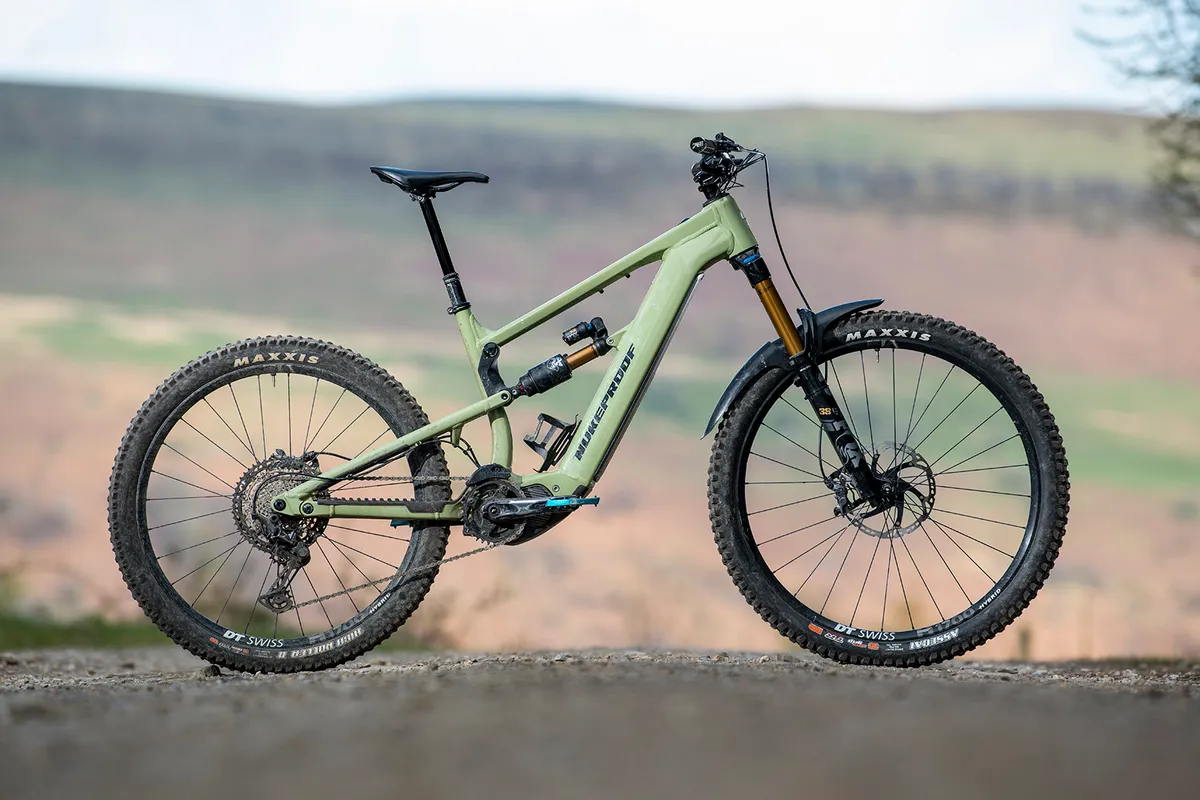
I was in awe of the Megawatt’s playfulness and ability to defy its weight figure. The same is true for the E-Sommet.
A few spec changes aside – DT Swiss H 1700 hoops feature on the Megawatt, and Nukeproof Horizon V2 on the E-Sommet – there are similarities between the two bikes.
Shimano’s XT M8100 drivetrain and brakes feature, and they share a Maxxis Assegai and High Roller II tyre combination. Both also use the Shimano EP8 motor and 630Wh battery.
Ridden back-to-back on the trail, there's very little to distinguish them.
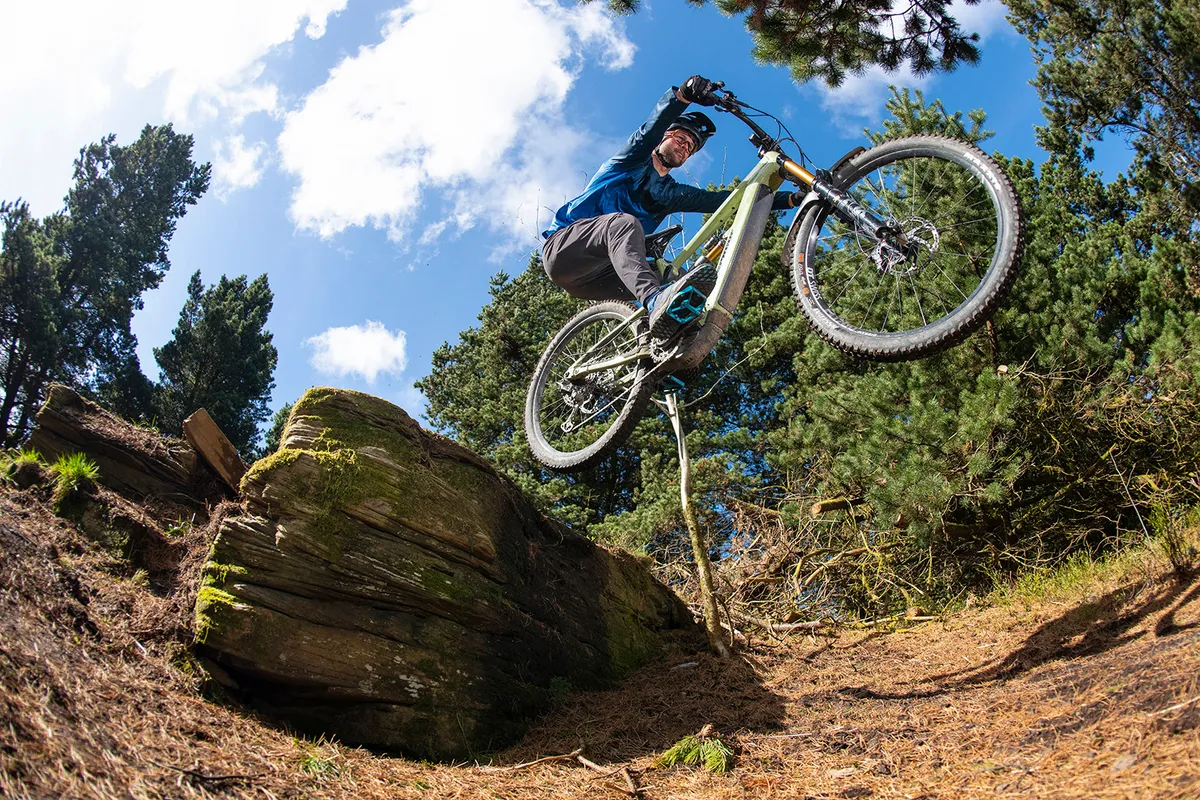
This does beg the question, going on performance alone, why would anyone choose a Megawatt over the more affordable and equally good E-Sommet VRX?
The answer to that could be the shop-bought after-sales support you get with the Megawatt, or the minor, but important to some, spec changes.
I’m not saying you shouldn’t consider the Megawatt if you’re in the market for an ebike, but you should seriously consider the E-Sommet VRX if you’re looking for a bike of this ilk.
Vitus E-Sommet VRX performance details
- Rear-shock tune: The rear shock’s light tune is welcome, and it’s a significant contributing factor to the rear end’s supple action. Setting it up requires a different approach to the over-damped shocks fitted to many bikes. Bigger or harder riders will need to increase spring pressures and add volume-reducer spacers to get the support they need, but lighter riders – those usually overlooked with damper tunes – will benefit from better-performing suspension.

- Water bottle bosses: Locating the water bottle bosses inside the front triangle leads to compromises. While the large bike can fit a 630ml bottle in a standard cage, the top of the bottle contacts the underside of the top tube. If the bosses were located further down the down tube there would be more space and it would still leave plenty of room for the rear shock’s piggyback to not contact the bottle as it cycles through its travel.
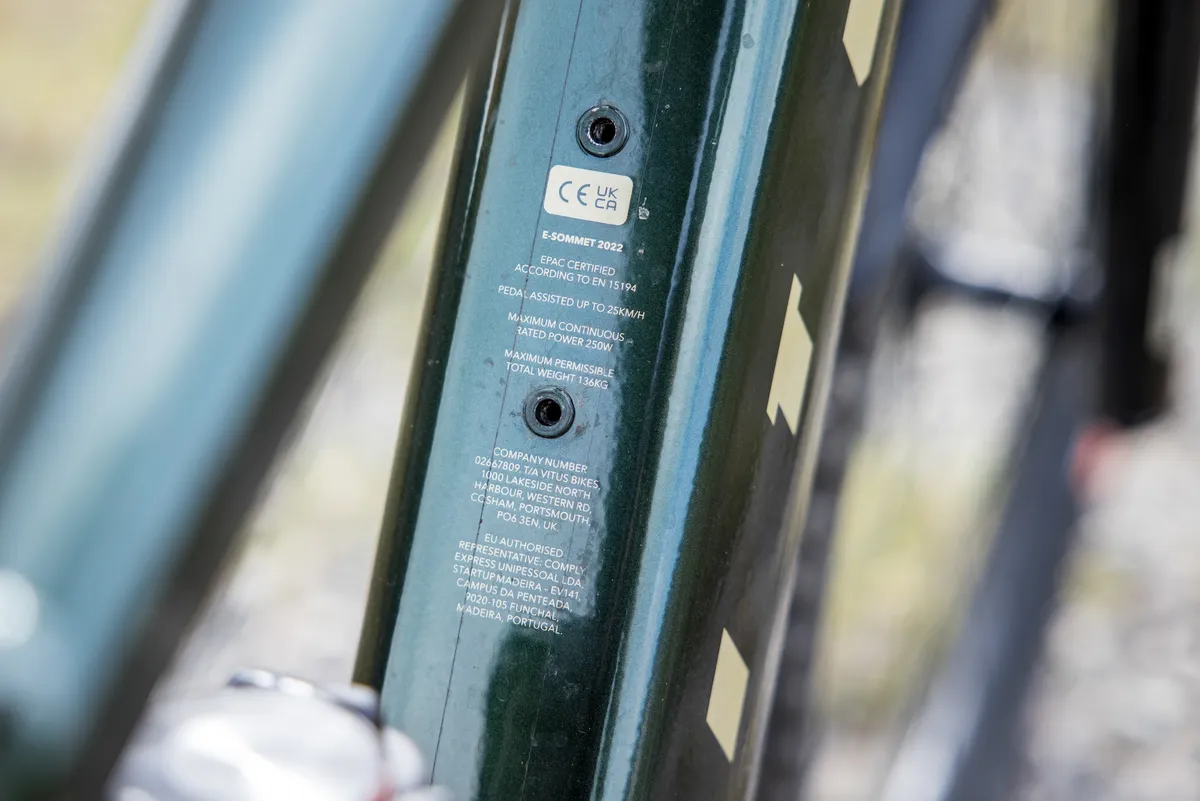
- Cable routing: Routing the cables through the headset looks neat and tidy, and reduces cable loops at the front of the bike. But the un-plugged cable ports let water enter the headset. Over time, this will likely impact bearing longevity.

- Wide rocker: I found my knees bashed into the suspension’s wide rocker. Not every rider will have this issue, but many could suffer from comfort issues.

- Speed sensor: The speed sensor’s cable guide is located close to the rear disc rotor and came unstuck from my test bike’s frame after one ride. I needed to secure the cable in place with a zip tie. If you own an E-Sommet, I highly recommend making sure your speed sensor cable is secured properly.

Vitus E-Sommet VRX bottom line
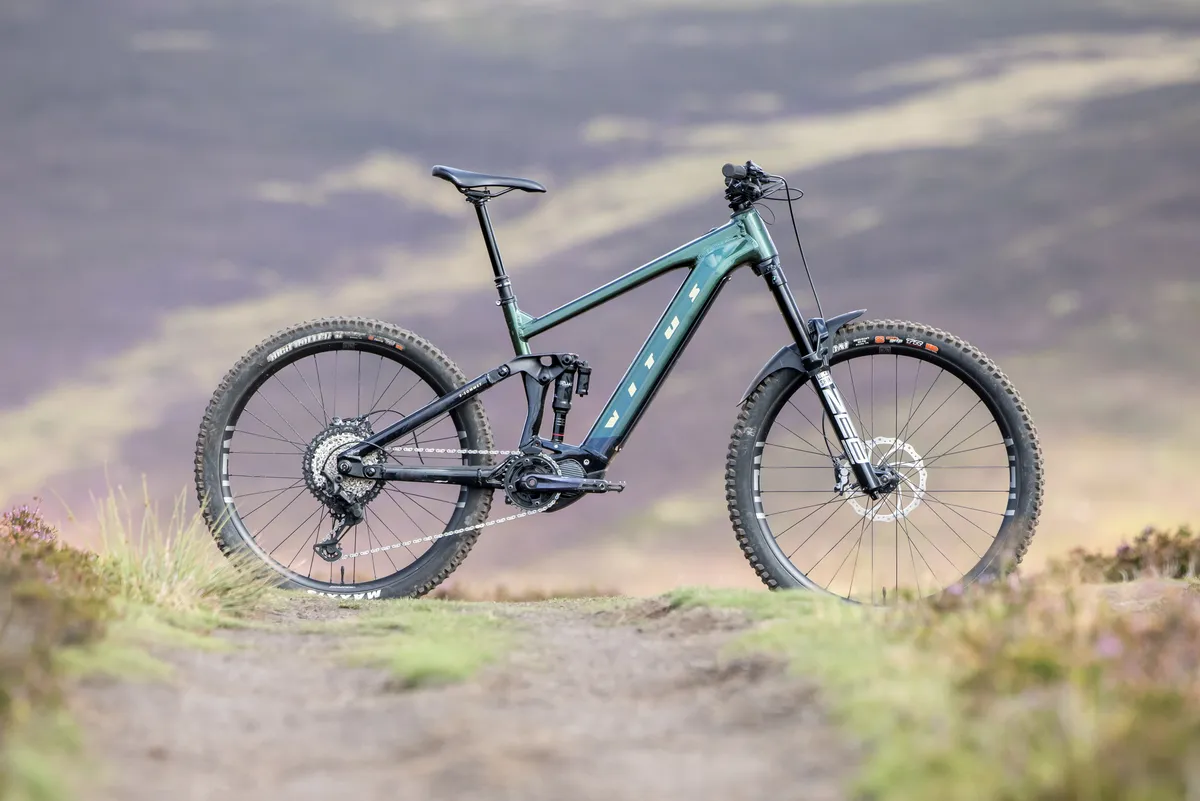
Vitus has nailed the price-versus-performance balance with the E-Sommet VRX. It delivers an impressive spec for what is, in context, a rather modest price.
That spec is backed up by a ride that’s intuitive, easy to get on with and masses of fun, but also highly capable for faster, more experienced riders. The supple suspension will suit many, too, and is impressively adaptable for lighter and heavier riders alike.
A few very minor niggles aside, the E-Sommet VRX is as close to perfect as you can get for the cash.
Product
| Brand | vitus |
| Price | 6999.99 EUR,5499.99 GBP,6099.99 USD |
| br_whatWeTested | 2022 Vitus E-Sommet VRX, size large |
| Weight | 25.2000, KILOGRAM (Large) - Size large, without pedals |
Features
| Fork | RockShox ZEB Ultimate CHarger 2,1 |
| br_stem | Nukeproof Horizon |
| br_chain | Shimano XT M8100 |
| br_frame | Vitus E-Sommet |
| br_motor | Shimano EP-8 |
| Tyres | Maxxis Assegai 3C MaxxGrip DD TR 29x2.5in f, Maxxis High Roller II 3C MaxxTerra DD 27.5x2.5in r |
| br_brakes | Shimano XT M8120 |
| br_cranks | Shimano XT M8150, 34t |
| br_saddle | Nukeproof Horizon Enduro |
| br_wheels | Nukeproof Horizon V2 |
| br_headset | Acros AXZ-589 |
| br_shifter | Shimano XT M8100 |
| br_cassette | Shimano XT M8100 |
| br_seatpost | Brand-X Ascend Dropper |
| br_gripsTape | Vitus Lock-On |
| br_handlebar | Nukeproof Horizon V2 Riser |
| br_rearShock | RockShox Super Deluxe Select+ RT |
| br_bottomBracket | Shimano EP-8 |
| br_availableSizes | Small, medium, large, extra-large |
| br_rearDerailleur | Shimano XT M8100 |
